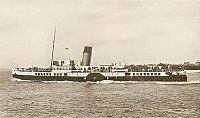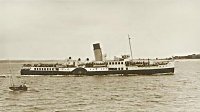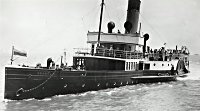
Prior to WW2 the "Southsea" and Whippingham" regularly ran excursions to Sandown, Shanklin, Ventnor, Round the Island, Bournemouth, etc., but due to Admiralty orders these ceased running on Thursday, 31st. August, 1939. On the next day the advertised morning service left the South Parade Pier as usual; but the Pier Manager telephoned to say that, owing to the prevailing conditions, there were no people on his Pier, and that in these circumstances he did not consider there was any use in continuing the steamboat service, and therefore, the steamers stopped calling there at once.

On that day, the 1st September, and the next day, Portsmouth Schools and many hospital cases were evacuated from the City, and many of these were taken to the Isle of Wight. The company ran 16 special services from Clarence Pier, and a total of 5,281 passengers, adults and children, were carried.
On the 3rd. September, 1939, war was declared and the Portsmouth fleet at that time consisted of 10 vessels:
| Passenger Steamers | Car Ferry Vessels | ||
| Ryde | 1937 | Hilsea | 1930 |
| Sandown | 1934 | Wootton | 1928 |
| Southsea | 1930 | Fishbourne | 1927 |
| Whippingham | 1930 | ||
| Merstone | 1928 | ||
| Portsdown | 1928 | ||
| Shanklin | 1924 | ||
They were all working the summer service, but from this date modifications to the service were made to meet the special circumstances prevailing. On Monday, 11th September an emergency service was brought into force which continued, with only minor adjustments until the 4th July, 1940, when Clarence Pier was closed by the Military Authorities and the boats could no longer use it. The service could be run with the use of only two steamers, but other vessels had to be used for special military movements, prison removals, etc. Only one Car Ferry was required for the reduced service, except when special military traffic necessitated an additional ferry being brought into use.

The paddle steamer "Sandown" was requisitioned by the Government and left Portsmouth on the 27th. September,1939 for Southampton where she was converted into a minesweeper by the Company. She was then in the Dover flotilla under the command of Acting Commander K.M. Grieg R.N. (ret.) who acted as Senior Officer of the flotilla. Her pennant number was J20.
The P.S. "Ryde" was similarly requisitioned and left Portsmouth on the 27th February, 1940 for Messrs. Camper and Nicholson's yard at Northam and, after conversion, she joined the "Sandown", under the command of Lieutenant (later Lt. Commander) J.C. Allen RNR. Her pennant number was J132. The two vessels, being well matched for speed (the "Ryde" being slightly faster), frequently swept together in an area which was a graveyard of ships which had been sunk by the new magnetic mines.
The P.S. "Southsea" was the next to leave Portsmouth on 28th. February, to the same yard for conversion. She was to undertake minesweeping operations on the North East Coast where she shot down an enemy aircraft in November, 1940. Sadly she had rather a short career, as she struck a mine in February, 1941, and had to be beached just inside the Tyne entrance near South Shields. After inspection it was decided that she was beyond reasonable repair and declared a total loss.

The German bombers had not yet started the Battle of Britain, but they objected to the "Sandown" and "Ryde" so carefully sweeping the mines that they had laid. The steamers, therefore, became the target for enemy planes, and they had the doubtful honour of being mentioned in the German radio Dispatches. "We shall bomb the "Sandown" and "Ryde" today if they go sweeping," was the sort of threat that came over the air. Both ships had several narrow escapes and the huge spouts of water completely hid them from the attacking aircraft and caused the Germans to report that they had been sunk.
The British Expeditionary Force was evacuated from France between May 26th and June 4th, and among the fleet of small ships which crossed the Channel to Dunkirk were five Southern Railway vessels. The "Sandown" and her flotilla crossed on the evening of May 27th. En route she answered a distress call from a drifter aground on the Goodwin Sands and took aboard 250 men who were then landed at Ramsgate. She set sail again and anchored off Bray Dunes where they started to load the exhausted troops. It was a hazardous and arduous operation; they were fired at by the shore batteries whilst the heavy swell made the work of the small boats difficult, but they managed to return to Kent with 910 soldiers.

The "Whippingham" was laid up at the beginning of the war, but she was hurriedly brought out to go to Dunkirk. On the 30th May, between midnight (29th) and 3.30 a.m. she left Portsmouth with the "Portsdown" and the Motor Car Ferries "Wootton" and "Fishbourne" and proceeded to Dunkirk, manned by Naval crews. The "Whippingham", commanded by Lieut Eric Reed, R.N.R., was designed to take just over 1,000 passengers, but they managed to return home with 2,700 men on board. She was so overloaded that the paddle box sponsons were said to be less than a foot above the water.
The "Portsdown", commanded by a young sub-lieutenant, sailed completely unarmed. Her crew managed to paint out as much of her white upperworks as possible, and made a dummy gun from wood and canvas. She was shelled and bombed when passing Dunkirk Harbour, her lifeboats had been destroyed so she was run onto the beach to load troops over the bow. She also returned home fully laden, having to ask directions from the cruiser "Calcutta" because of a defective compass.
According to information gathered from the officers in charge of the steamers on their return, a total of 4,400 troops were brought back from Dunkirk by the "Whippingham" and the "Portsdown". Although the car ferries reached Dunkirk they were not actually used for the conveyance of troops.
In 1941 "Whippingham" was sent for conversion, but she was severely damaged by a bomb which set back the work. She joined the 7th. flotilla at Granton at the end of the year under the command of Lieutenant Commander J. Mc.Glashan R.N.R. Her pennant number was J136. She was rather too late for minesweeping and was then equiped as an anti-aircraft vessel.

After a short time at Lowestoft, "Ryde" and "Shanklin" moved on to the Firth of Forth to join the 7th. flotilla at Granton to combat the acoustic mines being dropped there; and there was a great deal of sweeping to be done there in consequence, often at night. In October, 1940, Lieut. Commander E.T. Symons R.N.V.R. went to Granton to replace Lieut. Allen who was sick, on the "Ryde". He said they "had lots of escapades but no damage, a lot of hard work and a lot of fun and Edinburgh was only a 2½d. tram ride."
Back at home the three oldest steamers were maintaining the very reduced Portsmouth to Ryde service. Commencing on Wednesday, 10th July, 1940, the order prohibiting persons from entering the Isle of Wight for the purpose of holiday or pleasure came into force, which greatly curtailed the numbers able to travel to the Island.

On 20th September, 1941, there was a dreadful disaster. The "Portsdown" was on the 4am mail run from Portsmouth Harbour and was in the Swashway, a channel near Spit Sand Fort. It was the custom to empty the ashes from the furnaces overboard after leaving harbour so most of the crew would have been just forward of the paddle box to carry out this operation. It was almost dead low water, and they were in a position where Captain Chandler would have ordered an increase in speed. There was an enormous explosion which tore the vessel in half, just forward of amidships where most of the officers and crew would have been at that time, killing eight of the crew of eleven, including the Senior Captain, Mr. H.A. Chandler, his Mate, Mr. S. Burgess, twelve out of the twenty-nine service passengers and three out of eight civilian passengers.
Sam Jupe, a young deckhand who was bow look out, had a miraculous escape. Although injured and not a strong swimmer, he managed to dive over the side and, holding on to a piece of wreckage, swam to the stern where he climbed aboard. The bow section meantime had swung right round and turned turtle.
The stern sank but stayed on an even keel, with part of the deck above water. Mr. W.H. Kreutzer, the Chief Engineer and
Mr. H.J.O. Allen, the Second Engineer, had been further aft which saved their lives. Although injured and badly shocked the three survivors managed to launch the two lifeboats, saving many of the passengers.
On board that night had been Captain William Gibson who was due to relieve Captain Chandler at 6 a.m. It was quite usual to sleep aboard in order to avoid the difficulties of early morning transport to the Harbour Station. "Gibson had attended a function that night and was unable to get home to Portchester, so decided to come on board and snatch a few hours sleep in the after smoking cabin. By going to this cabin spared his life, for no doubt, had he gone to one of the duty officers' cabins he would certainly have perished; so he became a survivor."
Searchlights were played on the scene and small Naval boats were sent out to rescue the survivors who were taken either to Haslar Hospital or to the Harbour Pier. 2nd. Engineer Allen and Sam Jupe were taken to Haslar, but were soon released, although the former was to be some months before he fully recovered. The First Engineer was uninjured, but was suffering slightly from shock.
Early in the morning the Mate's twin brother, George Burgess, was cycling to the Harbour for the start of his duty, when a signalman called from his box that one of the steamers had been sunk. He hurried to the Harbour Station to discover that Seth, aged 33years, had been lost.
Mr. Pelly, Divisional Marine Manager, obtained the use of a Naval pinnace and by 6 a.m. went out to the wreck. With Mr. Traill, the 1st Engineer and two Deckhands they searched for survivors or bodies, but found neither. The bodies of the crew were never found, and at a later date a memorial service was held at Portsmouth Cathedralo The wreck remained visible at low tide until removed by the Admiralty in 1945.
Duty crew on the P.S. "Portsdown", 20th. September, 1941
| Master | Herbert A. Chandler | 30.5.1884 | 57 years |
| Mate | Seth Burgess | 17.2.1908 | 33 |
| Chief Engineer | William H. Kreutzer | Survived | |
| 2nd. Engineer | Henry J.O. Allen | Survived | |
| Purser | Edward Cottrell | 19.2.1907 | 34 |
| Seaman | Alfred Farey | 11.4.1880 | 61 |
| Seaman | John Monk | 6.4.1914 | 27 |
| Seaman | Samuel F. Jupe | Survived | |
| Ordinary Seaman | Eddie Burnett | 18 | |
| Fireman | William Harrison | 9.8.1893 | 48 |
| Fireman | Bertram Rawlins | 4.11.1915 | 25 |
By 1942 hundreds of modern minesweepers were available, so the paddlers were no longer necessary and they were transformed into anti-aircraft vessels. They guarded the east coast and Scotland at night from mine-laying aircraft and E-boats, shooting down a number of aircraft in the process. "Sandown" and "Ryde" were transferred to the Thames Local Defence Flotilla where they were kept very busy having to cover the area of the mouth of the Thames Estuary. "Sandown" was then moved to the Humber whilst
"Ryde" was sent to Portsmouth as defence against the flying bombs. The "Whippingham" was employed as an anti-aircraft guard ship for the convoy anchorage in Largs Bay, and was to take part in the Normandy landings.
At home the reduced service was being continued by the "Shanklin" and "Merstone". During the D-Day preparations the Portsmouth Harbour and Old Portsmouth sections of the City were "no-go" areas; there were barriers to stop all but those with special passes. For over a week before D-Day the crews of the steamers were kept on board their vessels, unable to return home, in order to keep secret the work they were doing in transferring thousands of troops from the Harbour Pier to the transports awaiting them at Spithead.
The car ferries were used to transport military vehicles. Mr. Charles Stevens, retired Clerk-in-Charge at Broad Street, vividly remembers being instructed to arrive at his office very early one morning; and as he cycled into the Guildhall Square
at about 6am seeing the end of a queue of heavy military trucks. As he continued southwards towards Cambridge Junction he felt a sense of shock when he realised that these would all have to be transported that day. They had arrived by special trains at the Town Station and were queued from there to the Point. The three car ferries worked all day without ceasing; as one load was disembarked the ferry immediately returned empty, at full speed, to pick up its next load. With careful packing it was reckoned that 17 cars could be carried, but that day they were attempting to get 16/17 trucks aboard. They worked all day to finish, exhausted, about 5 p.m.
All the remainder of the steamers and the car ferries were to survive the war; the "Whippingham", "Ryde" and "Sandown" were able to take their places once more in the Portsmouth Fleet.
Cynthia Sherwood